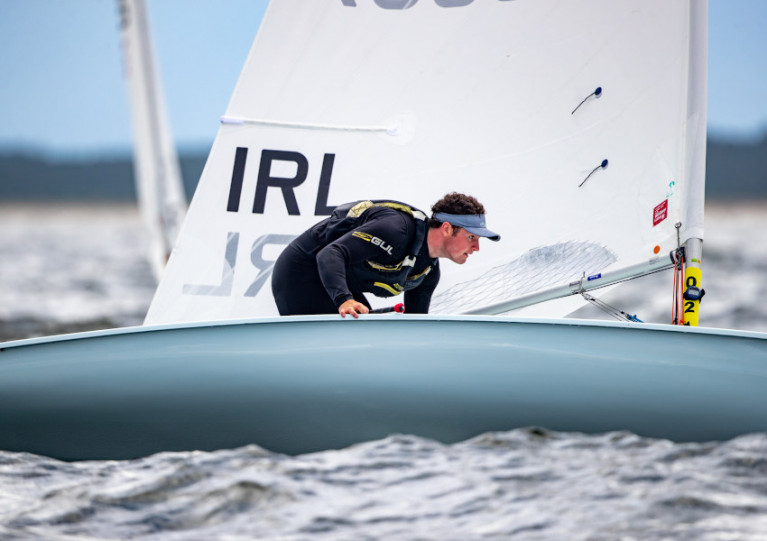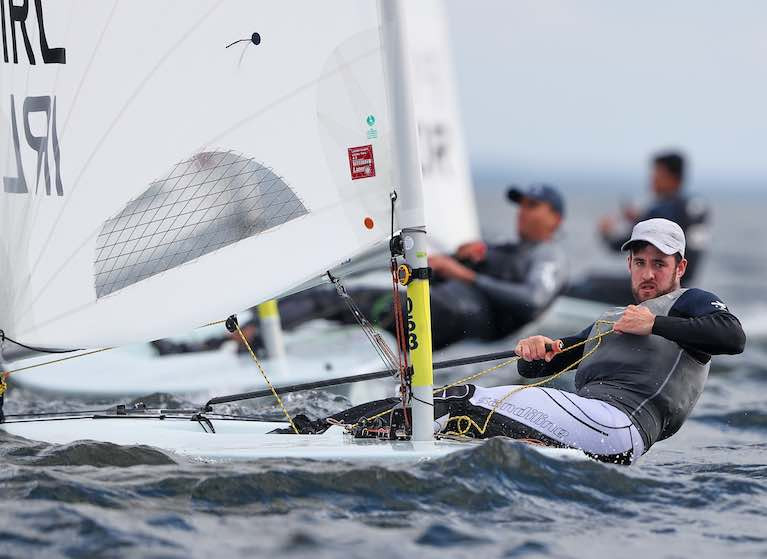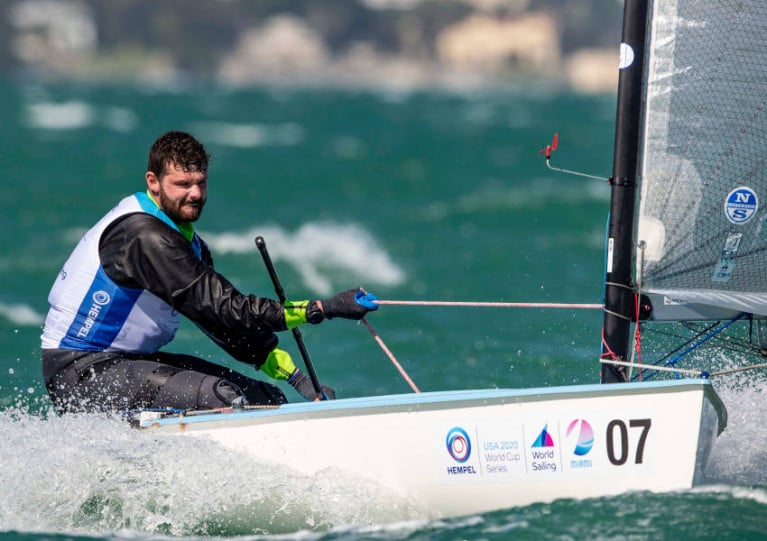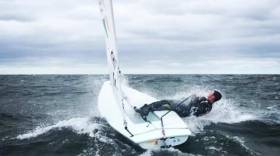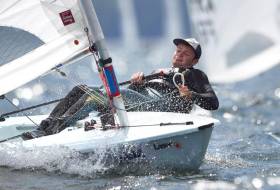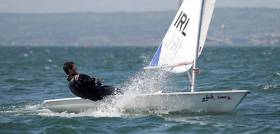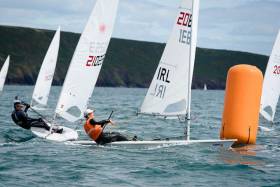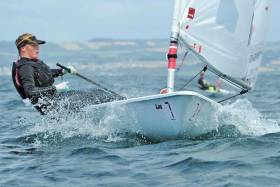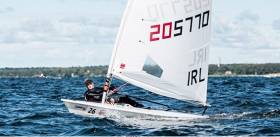Displaying items by tag: Liam Glynn
Three Northern Ireland sailors are all battling for a place at the Tokyo Olympic Regatta with qualification events taking place this week and in the next few weeks.
Ryan Seaton, Oisin McClelland and Liam Glynn have been training for over four years and are taking to the water in a bid to qualify the nation and secure their place at the Olympic Games in Tokyo.
In sailing, nations can qualify over ten Olympic disciplines but just one boat is eventually selected to represent each nation in each discipline.
The Northern Ireland athletes represent three different classes - the Finn, 49er and ILCA (formerly known as the Laser).
Double Olympic veteran and World Cup silver medallist, Ryan Seaton, from Carrickfergus, is paired with crew Seafra Guilfoyle from Cork, following his 10th place finish with Matt McGovern at Rio in 2016.
The pair had a solid start to this week's Regatta, which forms the final qualification event for the class. They had an 11-8-8 for the day in a 21 boat flight. Three days of qualification races will decide the split for Gold and Silver fleets on Wednesday that will go on to decide the medal race final on Friday (26 March) but currently, trail Dublin duo Robert Dickson and Sean Waddilove as Afloat reports here.
Ryan and Seafra finished 10th at the Olympic Test event in Enoshima and 30th at the 2020 World Championships.
Ahead of the race, Seaton commented: "It's all in, to qualify the nation. If we qualify, we will go to the Olympics. Seafra and I have been doing a serious amount of work over the past year, we are motivated and ready to put down a good performance.
"The outcome goal is to qualify for Tokyo 2021 and our process goals are to keep focused on our individual roles, to enjoy the racing and to believe in our ability as a team to perform.
"All the work is done now, and we are ready to enjoy the challenge. This is what it's all about, the big events, and performing at these events when it really counts".
Oisin McClelland of Donaghadee
Campaigning in the men's heavyweight Finn class since 2015, Oisin McClelland of Donaghadee has secured several results with the top 32 Worlds, 23 in the 2020 Europeans and a credible 8th in Kieler Week.
Portugal will host the Finn Gold Cup early this May and McClelland, which will be a big event for McClelland. It will not only determine the 2021 Finn world champion but also the final two places at the Tokyo Olympic Games.
There are two places left to decide, one European place and one African place to complete the fleet taking part in the Games.
 Oisin McClelland of Donaghadee Photo: Robert Deaves
Oisin McClelland of Donaghadee Photo: Robert Deaves
It is also the final World Championship for the class as an Olympic boat after the Finn was removed from the games for Paris 2024 and the future. The 2021 Finn Gold Cup will be decided over a 10 race series after the class decided to drop the medal race last year.
McClelland comments: "My primary goal is to qualify for Tokyo, it's the goal I have built this campaign around and I set out to achieve in 2016. However, that aside, this may be the last Finn Gold Cup held as an Olympic class I would really like to achieve a great result overall. I've made good progress despite the tough year, systematically targeting weaknesses and building them into strengths. I look forward to testing this in May."
He adds: "Give me the right conditions I can achieve some top-level race results, my focus going into the regatta is to combine the progress in each area of my training from the past three years and achieve the best result I can."
Liam Glynn, ILCA
For Liam Glynn of Ballyholme Yacht Club, the Olympic Qualifying event for the Lasers has been confirmed as the 2021 ILCA Vilamoura International Championship, taking place from 17-24 April.
This is the last chance for Liam to qualify the nation with two places up for grabs against Italy, Spain, Belgium and the Netherlands. Liam will be one of three other sailors to represent Ireland with stablemates Finn Lynch and Ewan McMahon.
 Liam Glynn of Ballyholme Yacht Club Photo: Thom Touw
Liam Glynn of Ballyholme Yacht Club Photo: Thom Touw
Rising through the youth and u21 ranks, securing a World Junior title and u21 Bronze along the way. Liam has shown steady progression in what is arguably one of the harder Olympic Classes to break. Most recently a 43rd in last October's European Championship shows encouraging signs for the future.
He comments: "I am looking forward to racing at the final Olympics qualification regatta. With two European spots still available to the goal is simple, finish in the top two non-qualified nations. I am very grateful for the opportunity to race against the best in the world, especially amid a global pandemic.
"It has been a challenging winter of training but I am pleased with my form and mindset in these final months preparation. I will set my sights firmly on what is achievable, with the help of my amazing support team, each day from now until the end of the regatta and enjoy the experience along the way."
Glynn adds: "It is an exciting prospect to be competing for Olympic qualification and I would love to give all the followers at home something to cheer for this summer."
RYA Northern Ireland's Performance Manager, Andrew Baker, says it is an exciting few months ahead for the sailors and supporters.
He comments: "These three events will be a milestone in the RYA Northern Ireland Performance Programme. Not only do we have three athletes representing across three different classes but they also stand out as large international events which over the past year have been few and far between due to Covid."
He adds: "I am very happy that we are in the position to have three sailors vying for Olympic qualification. All the sailors have worked their way through our club racing scene and performance pathways. The hard work is done, it is now time to trust in their training, believe in their ability and get out there to do it.
Personal Best For Liam Glynn At Laser Europeans In Poland
Ballyholme Yacht Club’s Liam Glynn has secured a personal best and 43rd overall after six days of racing against 126 international competitors at the Laser European Championships in Gdansk, Poland.
Northern Ireland sailor Glynn, who had been unable to train during lockdown, confirmed he is glad to be back in action — not least after starting the competition as the leading Irish sailor, topping Team Ireland’s Rio 2016 Olympic rep Finn Lynch.
“I feel so lucky to be back on the racing circuit,” he said. “We had offshore conditions most the week which made for some very high points racing but I was very happy with my tactical calls throughout the week.
“Growing up doing club racing in shifty conditions at Ballyholme has definitely paid off. It was nice to have some races at the top of the gold fleet and it brings me a lot of confidence for next season — if I can iron out a few weaknesses and get used to racing among the best sailors in the world.”
Looking ahead, the Belfast Lough sailor is some time off to reset and is then entering into training for the next season.
He said: “I have a few plans in place for the winter with Irish team camps and training regattas in Vilamoura, Malta and Palma.
“I hope to get away to events and training abroad but I am also lucky to have our team high performance centre in Dublin to continue training if travel becomes too difficult again.”
Andrew Baker, RYA Northern Ireland’s performance manager, shared his delight with Glynn’s latest performance.
He says: “Liam has continued to show progression within a world class international field. His result of 43rd is a personal best and his individual race results includes three in the top 15.
“I am looking forward to catching up with Liam when he has some time now at home and support him continuing into next season.”
Finn Lynch battled through the week to reach 13th overall in the Gold Fleet, while Howth’s Ewan McMahon placed 43rd in the Silver Fleet. The men’s Laser Radial saw Ireland’s highest placing, as Tom Higgins finished sixth (fourth among U21s).
As previously reported on Afloat.ie, Annalise Murphy finished the week in 27th, with performance team-mate Aoife Hopkins close behind in 32nd. Eve McMahon, sister of Ewan, placed 45th. Full results are HERE.
Belfast Lough's Liam Glynn Leads Irish Laser Men After Day One of European Championships
In the first day of racing in the 2020 Laser Senior European Men's Championships & Open European Trophy in Poland, Belfast Lough's Liam Glynn is 29th and top Irish sailor in the 126-boat fleet.
After two races sailed in flat water and a shifty medium breeze blowing off the land, Ireland's 2016 Rio Olympic rep Finn Lynch is 37th. Howth's Ewan McMahon is lying (89th).
The reigning 2019 European champion Lorenzo Chiavarini GBR (1-1) has started the championship with a perfect score, leading the fleet with two points. Filip Jurisic CRO (1-4) is second with 5. Italians Marco Gallo ITA (6-2) and Nicolo Villa ITA (6-3) are third and fourth respectively.
The British squad positioned two other sailors among this early top 10, with Elliot Hanson GBR (3-8) on fifth and Michael Beckett GBR (4-15) on sixth (9th overall).
Seventh place (8th overall) for Russian Sergey Komissarov RUS (13-5).
Places 6th, 7th and 10th overall for non-European sailors Clemente Seguel CHI, Juan Maegli GUA and Ryan Lo SGP.
The reigning 2020 World champion Philipp Buhl GER (22-6) is 18th among 126 competitors.
Results here
The countdown is on for three Northern Ireland sailors campaigning for their place at the Tokyo 2020 Olympic Games in late July this year, writes Betty Armstrong.
The athletes, who have been training for over four years, as part of their Olympic campaigns, will take to the waters on 11 April to battle it out at the nine-day qualifying competition in Genoa.
In the running is two-time Olympian and World Cup silver medallist Ryan Seaton, from Carrickfergus. Seaton paired up with new crew Seafra Guilfoyle from Cork in the 49er class, following his 10th place finish with Matt McGovern at Rio in 2016.
McGovern is now coach to the Irish 49er teams, all vying for an Olympic place.
Ryan and Seafra finished 10th at the Olympic Test event in Enoshima and recently finished 30th at the 2020 World Championships. They are embarking on a critical training phase in the lead up to the Olympic qualifier and subsequent European Championships in May.
Seaton comments: “Seafra and I have been training well and putting critical elements of speed and boat handling together over this winter period. Our focus has been to get more race practice and working under pressure to refine our performances and add consistency to a regatta week.”
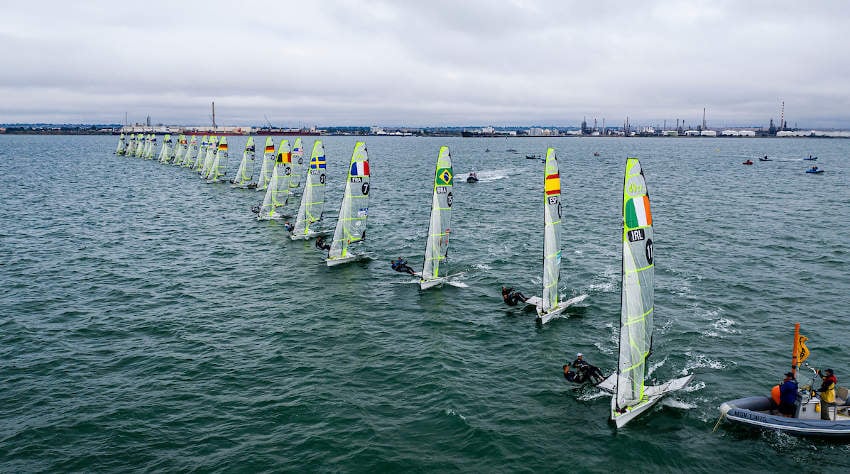 Ryan Seaton and Seafra Guilfoyle in action at the 49er Worlds in Australia last month | Photo: Jesus Renedo/Sailing Energy
Ryan Seaton and Seafra Guilfoyle in action at the 49er Worlds in Australia last month | Photo: Jesus Renedo/Sailing Energy
The Finn is a dinghy not normally associated with Donaghadee Sailing Club, but DSC member Oisin McClelland is another contender.
Campaigning in the men’s heavyweight Finn class since 2015, McClelland has secured several top 32 World and European finishes. In January he finished fourth in the Miami World Cup Series event, just narrowly missing out on a bronze medal.
He says: “Really nailing down all elements that make up a successful Olympic campaign was definitely difficult at the start but over time I have been able to get consistent and make big improvements.”
Ballyholme’s Liam Glynn is also gearing up for the challenge in Genoa. Rising through the youth and U21 ranks, he has secured a world junior title and U21 bronze along the way and recently achieved a personal best finish in the Laser at the recent World Championships in Australia.
As part of the Irish Performance Laser squad, the Bangor sailor has been training hard, with a typical day including up to six hours of training, looking at racing skills and focusing on nutrition and recovery.
Commenting on his Olympic campaign so far, Glynn says: “I am motivated by my love of the sport, the feeling when you are in the zone and perfecting your technique and strategy amongst the best sailors in the world.”
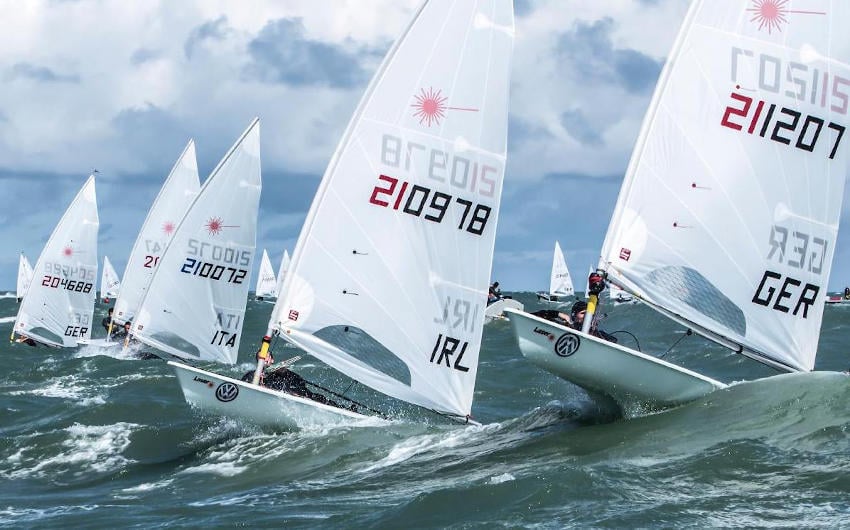 Liam Glynn recently scored a personal best result in the Laser
Liam Glynn recently scored a personal best result in the Laser
All three sailors graduated through the RYA Northern Ireland’s Performance Pathway and are funded through Sport Northern Ireland. Seaton and Glynn are members of the Irish Performance Team.
In sailing, nations can qualify in 10 Olympic disciplines but just one boat is eventually selected to represent each nation in each discipline.
For the NI athletes, their last chance for a European place in the Finn, Laser and 49er fleets is up for grabs at the Sailing World Cup next month.
RYA Northern Ireland’s chief operating officer Richard Honeyford, is looking forward to supporting the sailors as they make their final preparations.
“For all three boats the focus is now on one event in April and for the final chance to secure their place at Tokyo 2020,” he says. “All three have worked extremely hard during this Olympic cycle, with vast amounts of training, competing and travel to achieve their goal.
“At RYA Northern Ireland we are proud of how well they have applied themselves and their inspirational role as ambassadors for sailing in Northern Ireland.
“We look forward to the sailing community supporting them as they undertake this final challenge for Olympic qualification.”
Liam Glynn is 'Sailor of the Month' (Olympics) for July
Liam Glynn of Ballyholme is July’s “Sailor of the Month” (Olympics) after taking the Bronze Medal in the U–21 World Championship in Poland.
Glynn was Topper World Champion in France aged 13 in 2013, now at 19 he has demonstrated the success of his transfer to Lasers with this very competent third place in difficult sailing conditions, racing against a fleet of 133 boats from 40 nations.
As Afloat.ie reported earlier, at the U21 Laser World Championships in Poland today 19-year-old Ballyholme Yacht Club Sailor Liam Glynn from Bangor, Co. Down in Northern Ireland took a bronze medal from a fleet of 133 competitors spanning forty countries. The result adds to Ireland's youth medal haul in the Laser class over the past decade.
Glynn secured the medal in difficult shifty conditions on the Baltic Sea. On an outstanding penultimate day, scoring two third places, put him in pole position coming into the final day. A strong charge today by the two German sailors ultimately meant he missed the title but such was the strength of his series he still took the bronze medal.
As a junior, Glynn won the Topper World Championships in 2013. This second World Championship medal bodes well for his future potential in the Olympic discipline, where his main rival for the single Tokyo place is Dun Laoghaire's Finn Lynch a sailor who also performed at U21 level.
As Afloat.ie readers will recall, Ireland has previous success at World Radial youth level. Nine years ago, Wexford’s Philip Doran took the Under 17 world championship title in Japan in 2010. A year earlier he won the Under 16 title. In that same year, 2009, Annalise Murphy, then aged 19, won the Under 21 world title.
Glynn's rival Lynch took bronze in the Men's Radial Worlds, silver in the Europeans and gold in the U21 category at the Laser European and World Championships in 2013 on his home waters of Dun Laoghaire.
Today's qualifies Glynn for the Irish Sailing Senior Team in 2019, and he will now join this team to compete at the Olympic qualifier in Aarhus, Denmark in August
Bronze For Belfast’s Liam Glynn At U21 Laser Worlds
#Laser - Ballyholme’s Liam Glynn added to a stellar weekend for Irish sport when he won bronze at the U21 Laser Worlds in Poland this afternoon.
The phenomenal result saw the former Topper world champion come out tops in the sixth qualifier and score three straight third-place finishes in the eighth, ninth and 10th races of the week.
Two other Irish Laser sailors made the Gold Fleet at Gydnia, with Johnny Durcan placing 40th and Ewan McMahon 44th.
In the women’s Laser Radial competition, Belfast’s Sally Bell bowed out after four races to place 70th overall.
The scoreline's impressive but it belies the fact that on the water the National Yacht Club's Finn Lynch is not getting things all his own way at Royal Cork Yacht Club's Laser National Championships. A string of wins came to an end in race six this morning when Tokyo 2020 rival Liam Glynn, the former Topper World Champion, took the gun but it was business as usual in races seven and eight as Lynch built a six–point advantage over the Ballyholme YC man. Royal Cork's own Nick Walsh is third but some 17–points off Glynn.
Although Johnny Durcan made the tough decision to sit out the Laser Radial Worlds in Medemblik, Holland after day two (he was lying thirteenth after the first day) the Cork helmsman, who is recovering from injury after a capsize in California, was in fact back in action at the Nationals today, on the third day of competition in the full rig division, and counted a 3,4,2 to be right up there with Olympic trialists, Lynch and Glynn. See the standard rig results here.
Race officer Peter Crowley sailed the combined fleets in a westerly breeze outside Cork Harbour today.
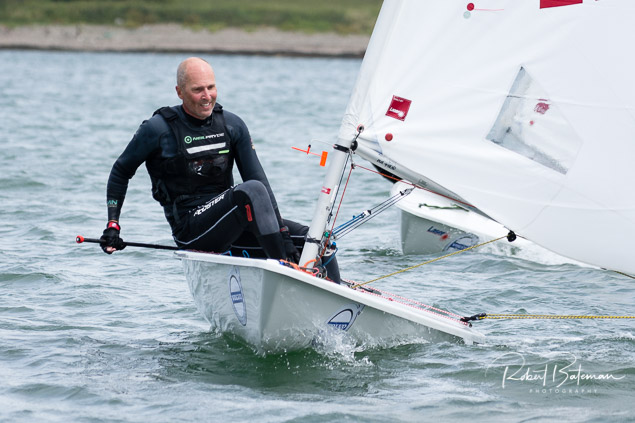 Sean Craig moves up to second overall in the 32-boat Radial fleet after eight races sailed Photo: Bob Bateman
Sean Craig moves up to second overall in the 32-boat Radial fleet after eight races sailed Photo: Bob Bateman
Royal Cork's Luke McGrath stays top of the Radials and he has 20–point margin over Sean Craig, a recent Radial rig convert, who has moved into seconf place. The Royal St. George multi–champion is now four points clear of club mate Patrick Cahill on 36 points. Read the Radial results here.
In the 4.7 fleet, Jack Fahy also maintains his overall lead with a seven point cushion and in a show of strength for the Royal St. George Yacht Club, another George helmsman is second with Tom higgins counting 18–points. Third is Michael Carroll from Kinsale YC. 4.7 results are here.
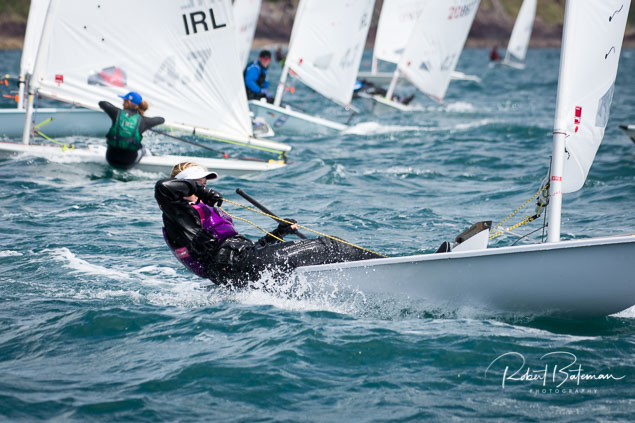
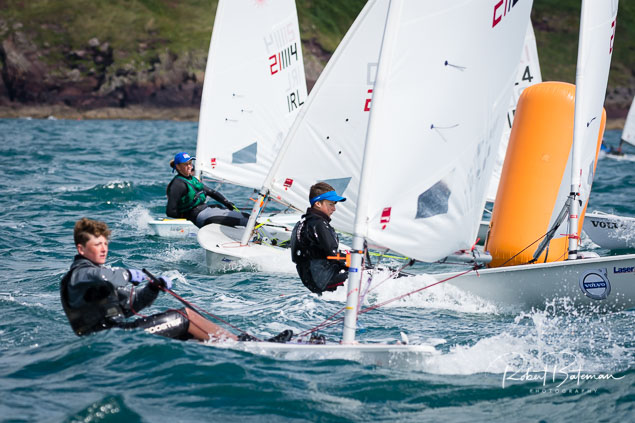
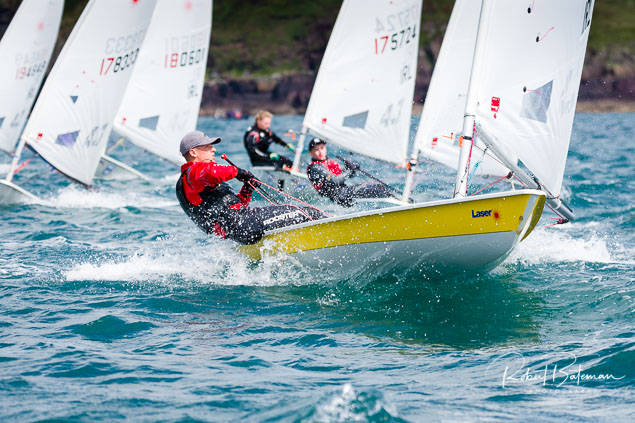
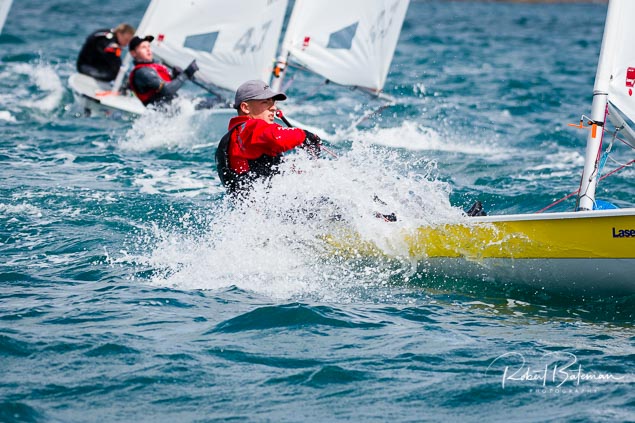
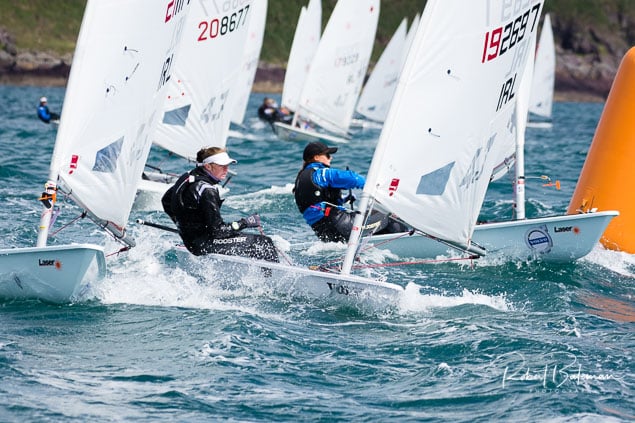
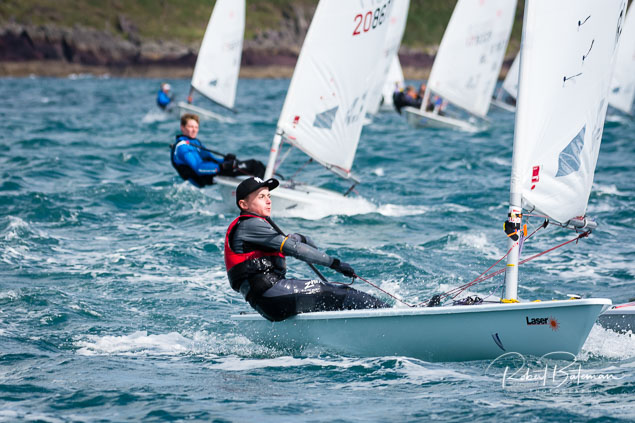
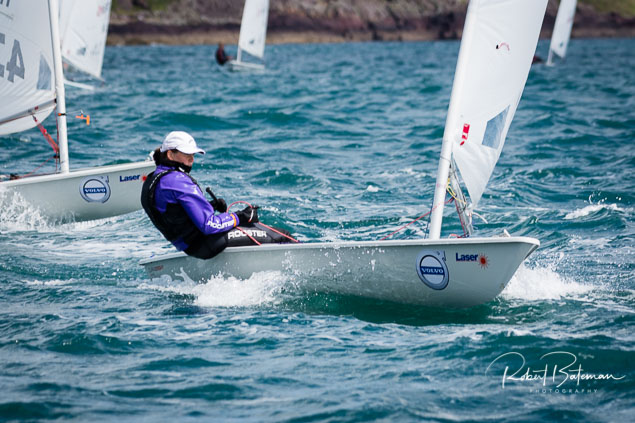
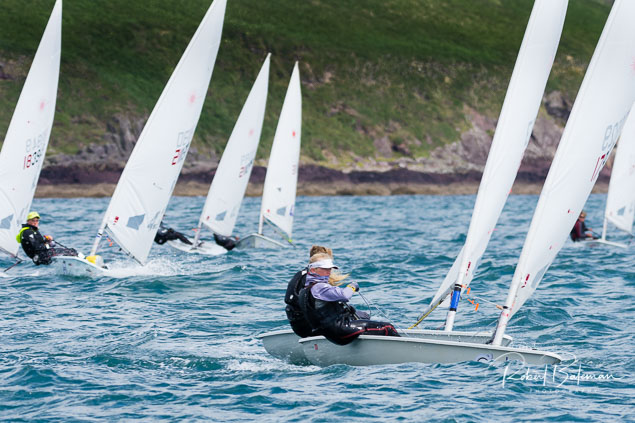
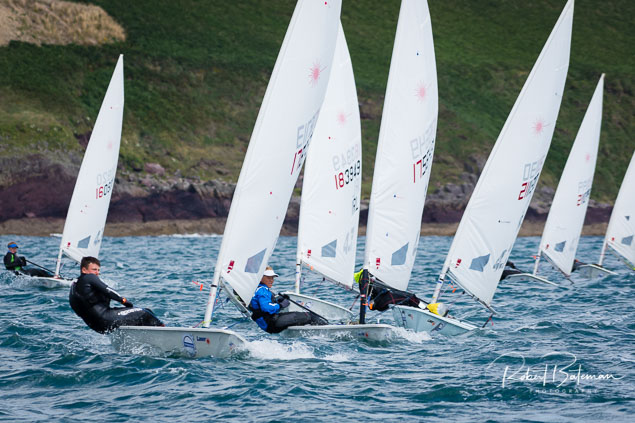
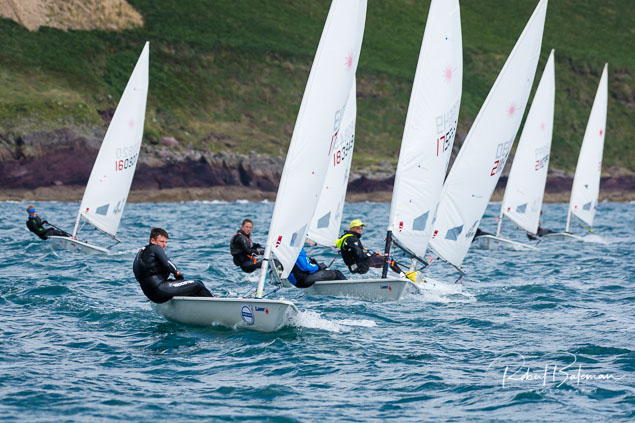
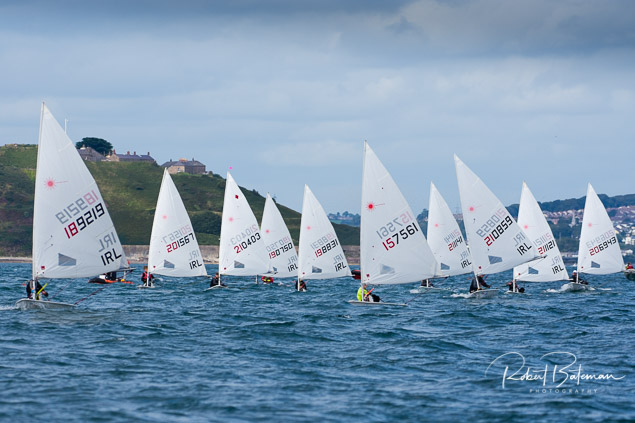
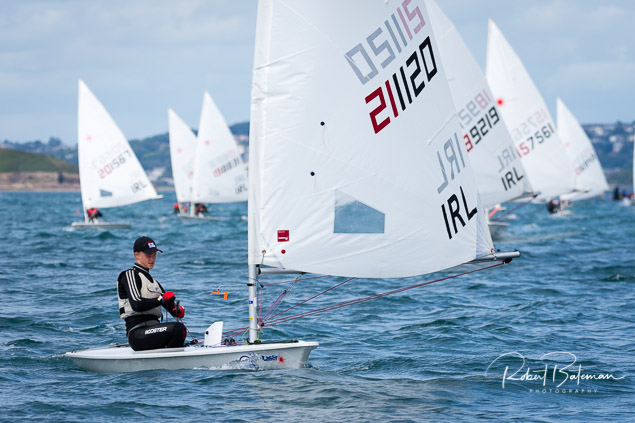
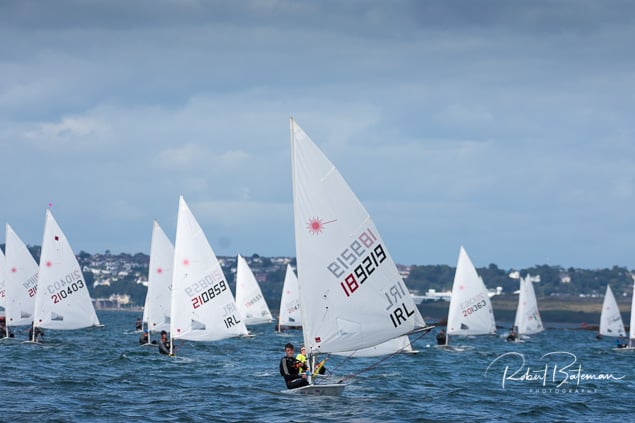
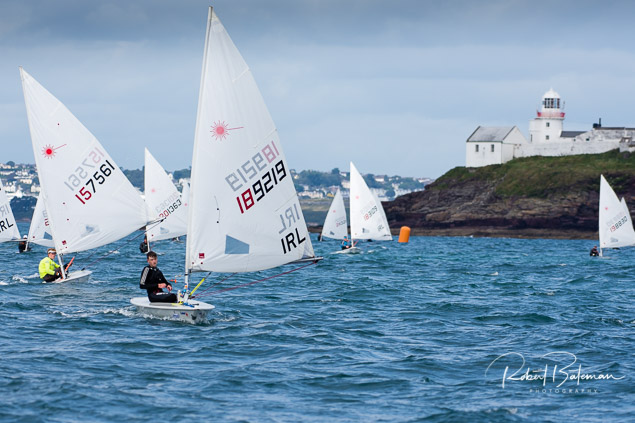
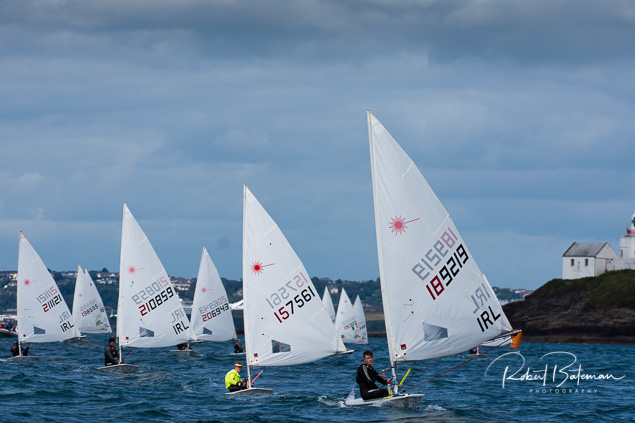
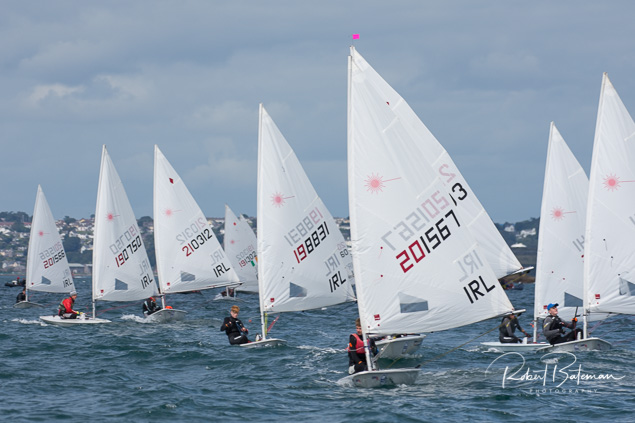
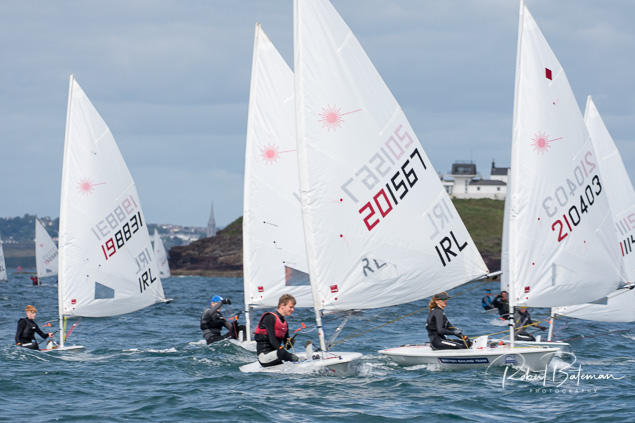
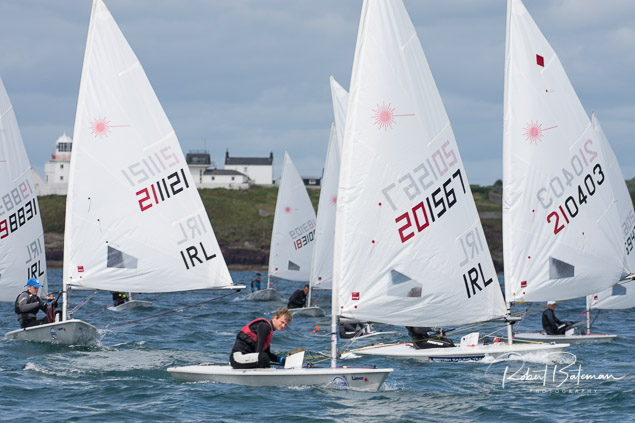
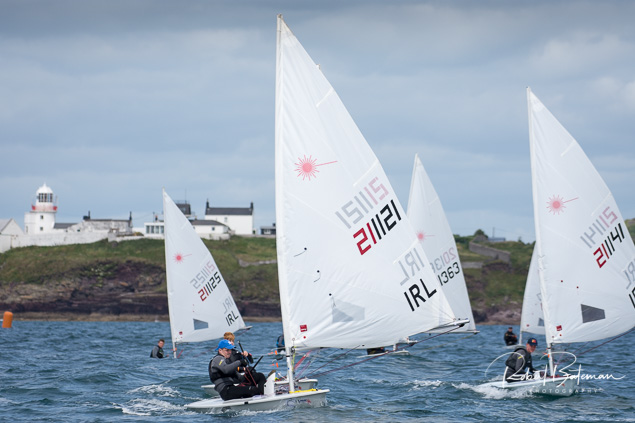
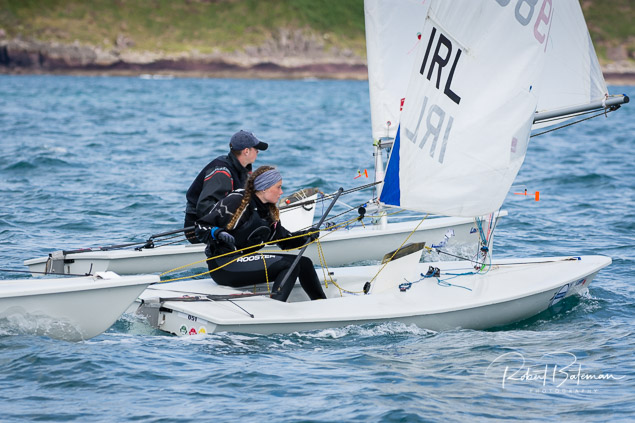
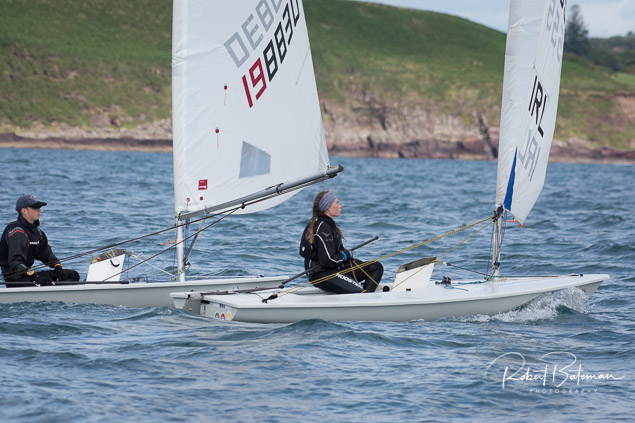
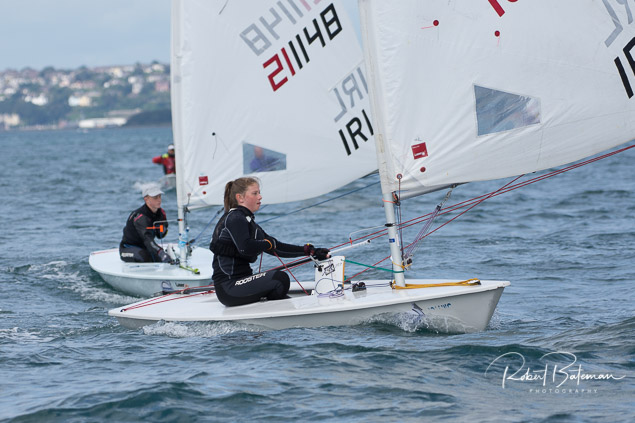
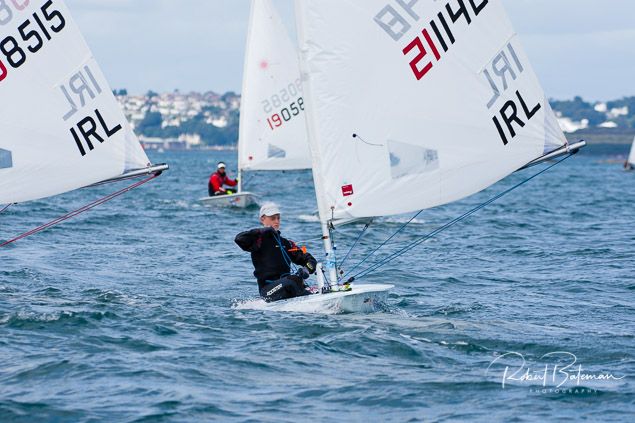
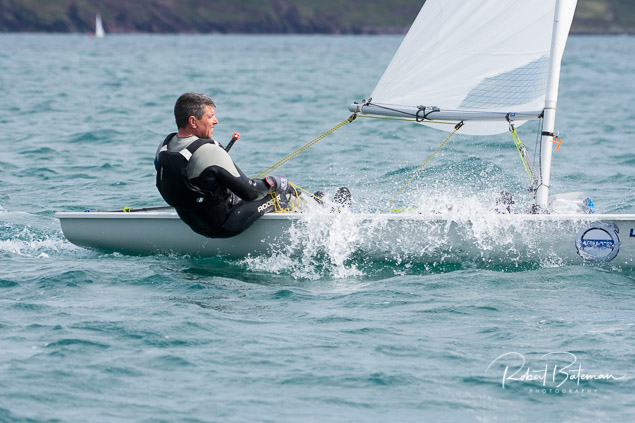
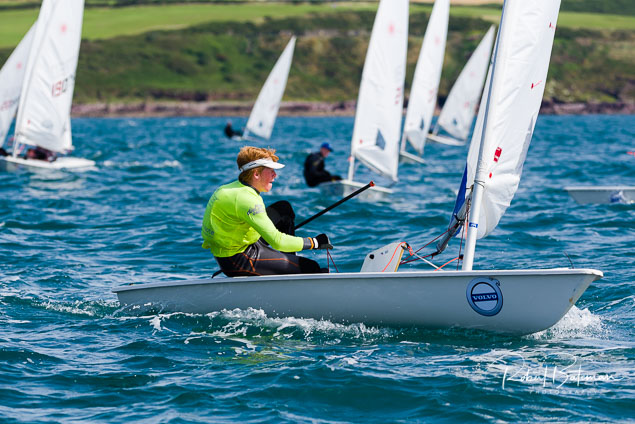
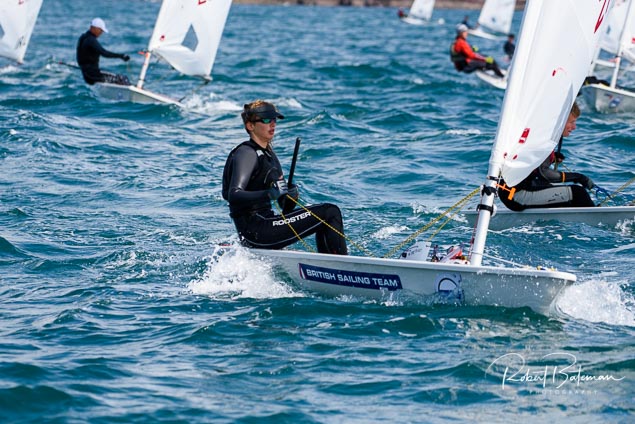
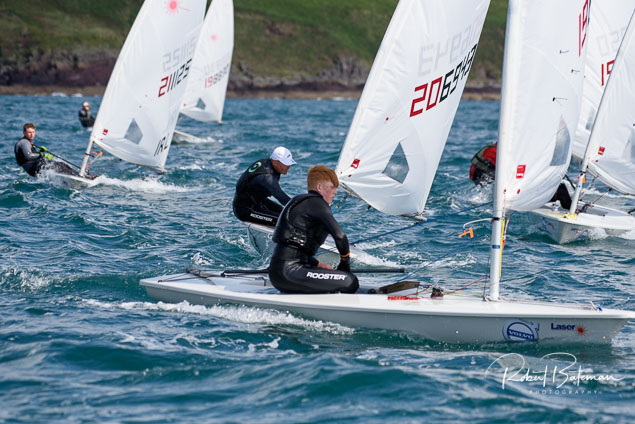
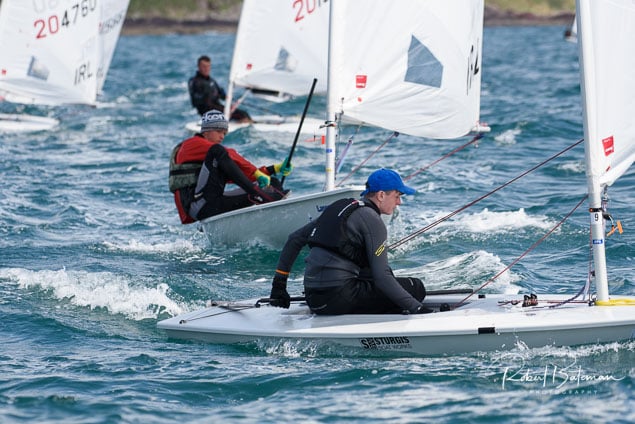
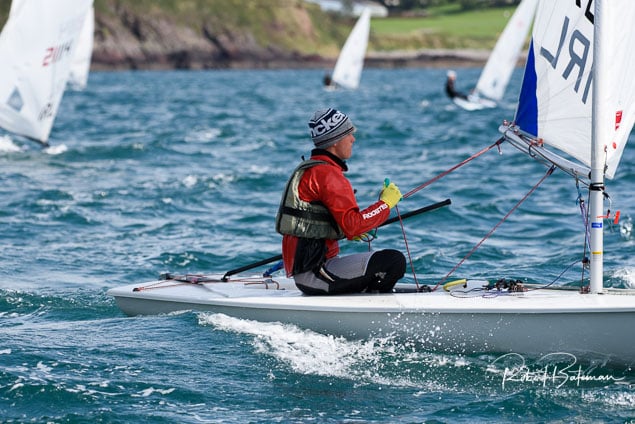
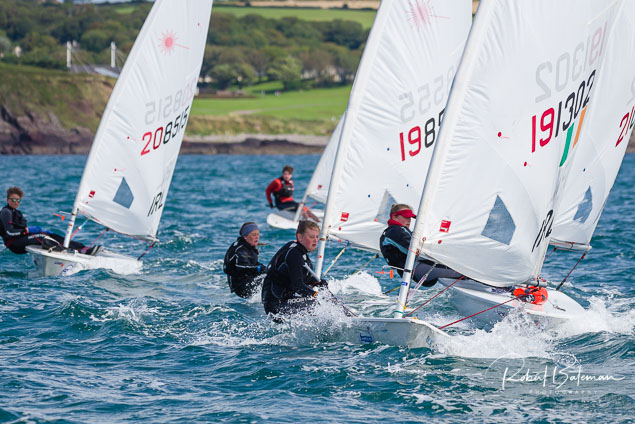
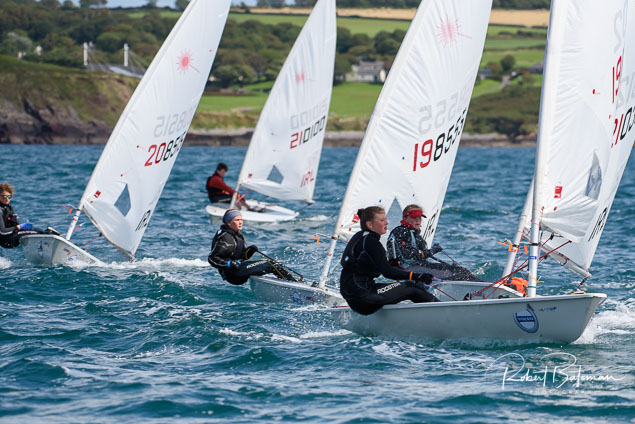
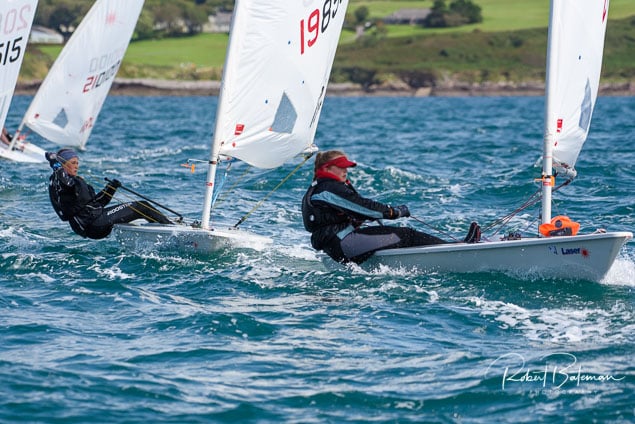
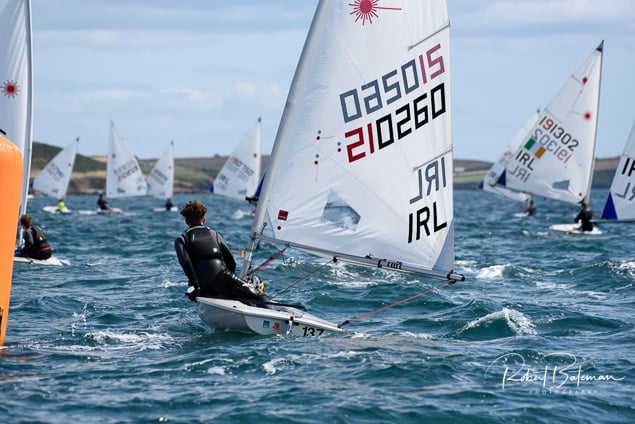
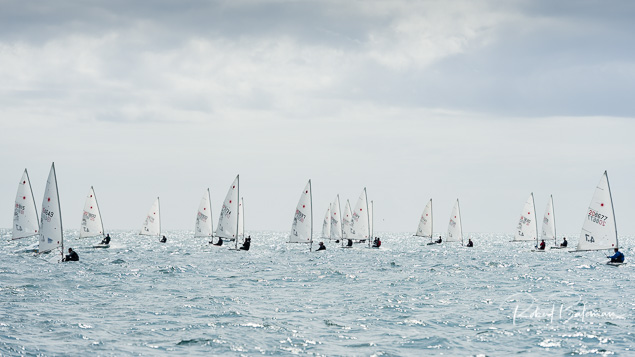
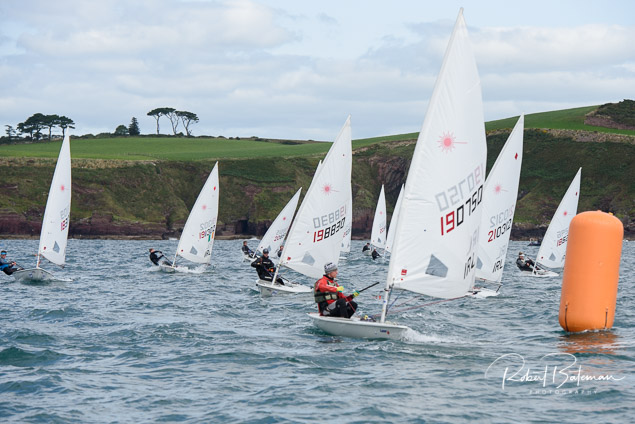
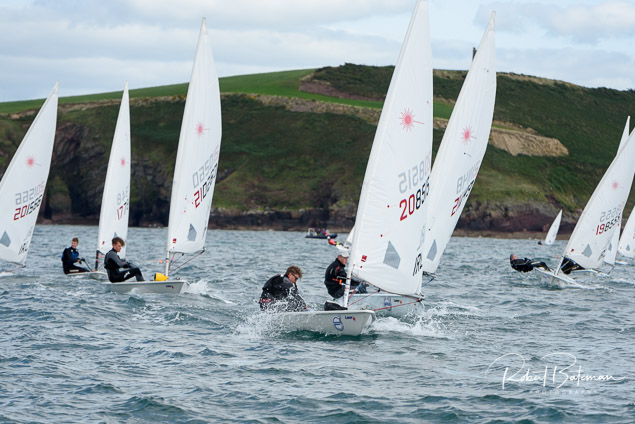
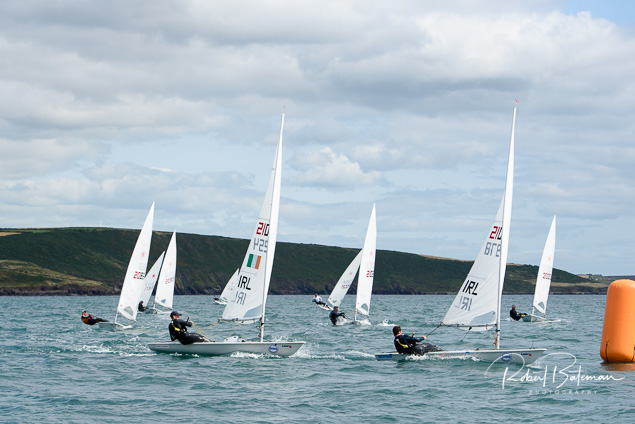
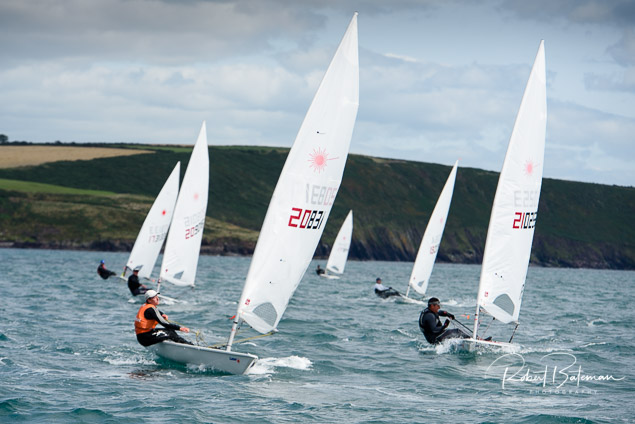
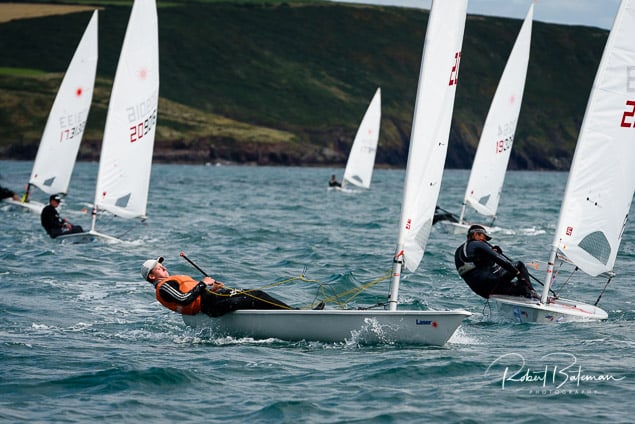
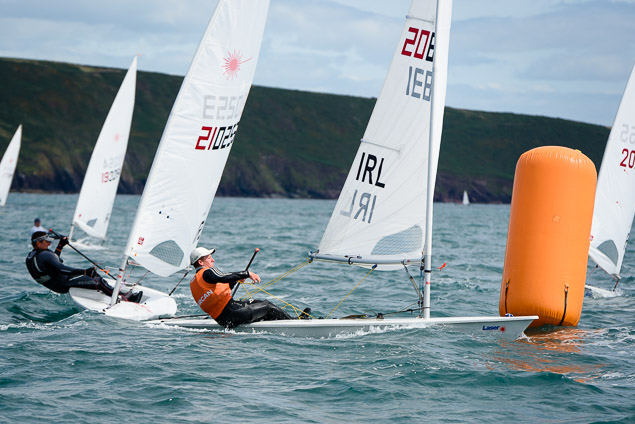
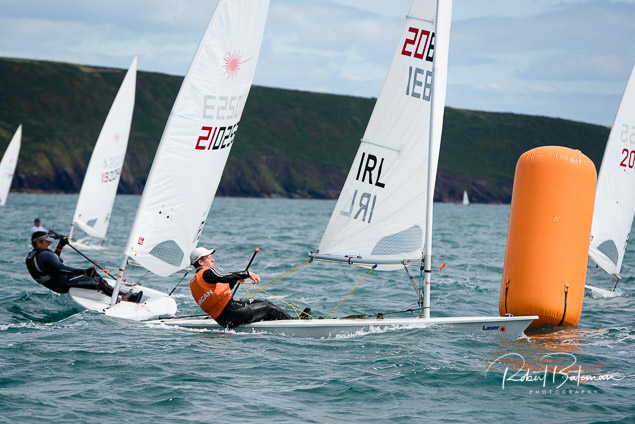
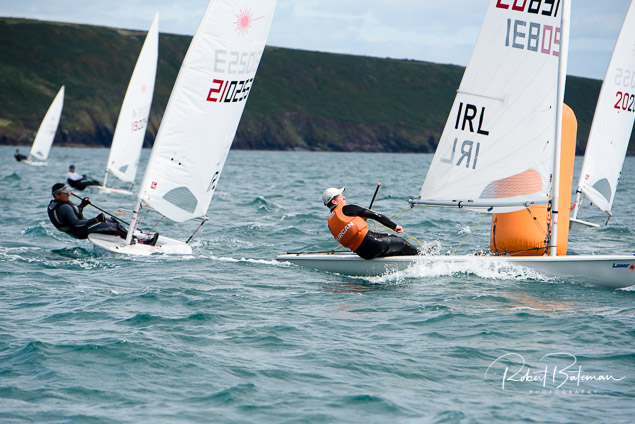
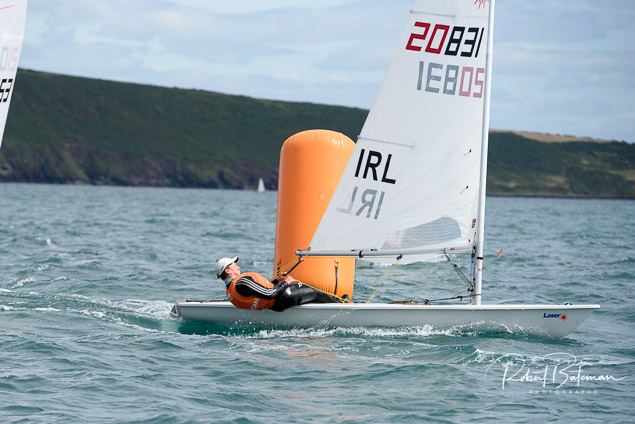
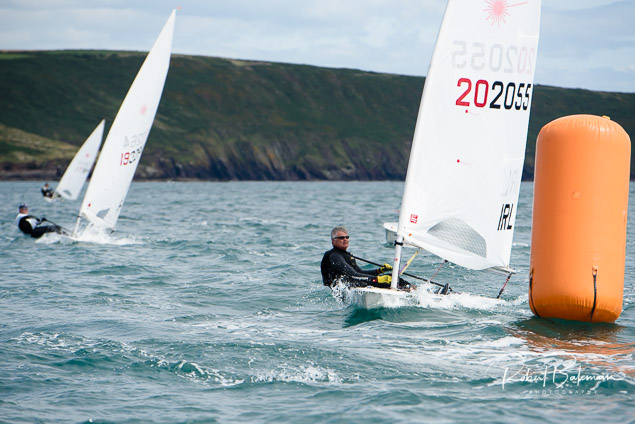
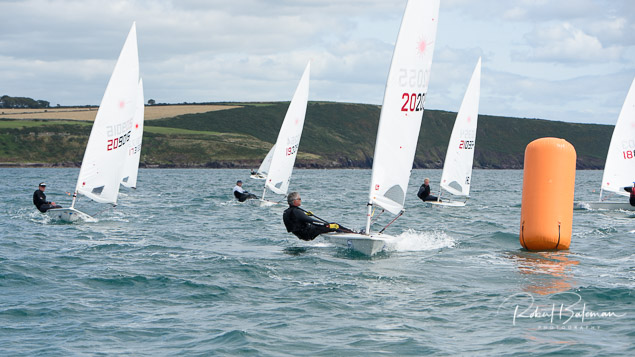
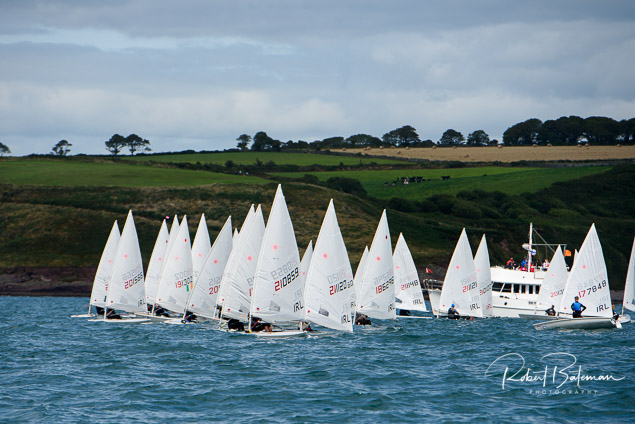
#Laser - Aoife Hopkins took the lead at the U21 Laser Radial Women’s Euros in Douarnenez yesterday (Thursday 20 July).
As previously reported on Afloat.ie, the Olympic triallist from Howth Yacht Club had been just a single point off the lead after the first two races.
But two strong performances in yesterday’s two races and this morning’s single outing have put Hopkins on top, two points ahead of fellow Irish sailor Aisling Keller of Lough Derg YC.
Racing was postponed after race five due to strong winds with gusts of 35 knots. The event is set to resume with the start of the final series tomorrow (Saturday 22 July).
Elsewhere in Douarnenez, former Topper World Champion Liam Glynn from Ballyholme YC has climbed up the rankings of the boy’s Laser fleet to seventh overall after five races.
Liam Glynn & Aoife Hopkins Both Fourth At Laser Youth Euros, Ewan McMahon Retires from Tallinn Regatta Due to Illness
Ballyholme Yacht Club's Liam Glynn, the one time leader of the Laser Radial Youth European Championships in Estonia, finished fourth overall in the 69–boat gold fleet yesterday. The championships, sailed in the Bay of Tallinn, was raced over eight races with one discard and a variety of sailing conditions. No racing was possible yesterday due to lack of wind.
In the gold fleet, Ireland's Conor Quinn was 65th and Peter Gilmore 69th, according to the official results HERE.
Earlier in the series, overall results for Ireland’s World Youth silver medallist Ewan McMahon indicated the Howth Yacht Club sailor was still competing in Tallinn when in fact he had been forced to withdraw due to illness. Ewan was hospitalised in Estonia last Thursday before returning home to Ireland on Saturday.
In the girls fleet, McMahon's club–mate Aoife Hopkins finished fourth on equal points with the bronze medallist, Carolina Albano. Official results HERE.
At the same time, another Irish Laser youth team is competing at the Laser U21 World Championships in Kiel, Germany.
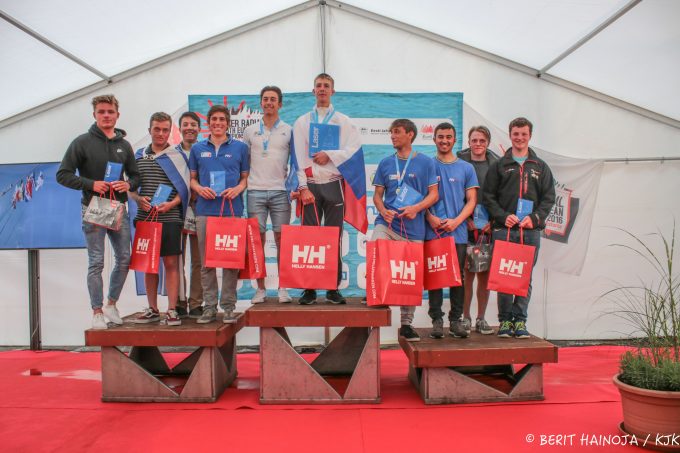 The U19 Boys Top 10 at the Laser Radial Youth European Championship 2016, Tallinn, Estonia. Ballyholme's Liam Glynn is pictured extreme right. Photo Berit Hainoja/KJK
The U19 Boys Top 10 at the Laser Radial Youth European Championship 2016, Tallinn, Estonia. Ballyholme's Liam Glynn is pictured extreme right. Photo Berit Hainoja/KJK
Final Race report by organisers:
Today was the last day of the 2016 Laser Radial Youth European Championships in Kalev Yacht Club for U17 and U19 age groups. Weather was tricky also on the last day. If, until so far, we had struggled with too much wind, then the situation today was the opposite and after a long wait no races were held, despite many attempts. European champions in youth U17 and U19 groups were based on the results announced yesterday evening. Both girls’ European champions are from Germany: Hannah Anderssohn in U19 and Laura Schewe in U17. Daniil Krutskikh from Russia is the new European champion both in boys’ U19 and U17 groups.
Laura Schewe from Germany, who was leading the U17 group from the very first day, was very pleased with her performance and the whole regatta. „I had to concentrate very hard not to let competitors pass me. I was sixth overall and my peers were also racing very well. Especially Valeriya Lomatchenko from Russia who finished eighth in overall. The race committee did a very good job and we could enjoy some fair and honest sailing. Tallinn is a beautiful city and we loved our time here,” commented Laura after the prize-giving ceremony. Girls’ silver in U17 belongs to Valeriya Lomatcenko and bronze went to Wiktoria Go Biowska from Poland.
U19 European champion Hannah Anderssohn, who finished first four times, third three times and sixth once, was also overjoyed: „Conditions were very complicated but all races were very fair as the race committee did a great job. I was in the lead yesterday and felt very optimistic about today as I had been sailing a stable series and I did not care about the second discard. I would like to thank my competitors for a great regatta – it was really nice here and I’m very pleased about winning.” Girls’ U19 silver went to Louise Cervera from France who was six points behind the winner. Carolina Albano from Italy, who had been leading the regatta for most of the time, lost her position on the last day of races due to an abandoned race because of a broken mast. She finished third, ten points behind the winner.
The only Estonian girl Maris Seersant from Tallinn Yacht Club finished 23rd being very content with her sailing: „I have not been sailing Laser Radial very long yet and therefore I’m quite happy about my even series and position in the middle of the fleet. As we had really strong winds most of the time, everyone dreamed of quieter days which never came. However, I’m very glad I could race such among such strong competition at a home regatta.”
The first three among U19 boys all finished within three points, whereas the second and third have an equal score. Daniil Krutskikh from Russia, who became Laser Radial U17 world champion a couple of weeks ago in Ireland, was quite unreachable for his competitors in Tallinn also. He finished first four times out of eight races, which meant that the rest, 9th, 22nd and 29th result, did not stop him from winning the title both in U19 and U17 groups. „The entire week we had to race in strong winds and big waves where is hard to handle the boat, but I have practiced these conditions a lot in Italy under my dad who is my coach – this gave me good chances here too. The competition in Ireland at the Worlds was stronger, unfortunately my main competitors from Spain and the Netherlands did not come to Tallinn – this is why I had more chances to take the title in U19 too. I really enjoyed the regatta here and I’m overjoyed about the results” commented the new European champion happily. Daniel Whiteley from England was three points behind him and finished second in U19.
Bronze went to Paolo Giargia from Italy who had the same amount of points. The only Estonian in the gold fleet was Tavo Annus who finished 41st overall.
The silver on U17 went to Milo Gill-Taylor from England and Wojciech Klimaszewski from Poland earned bronze.
The closing and prize-giving ceremony was held in Kalev Yacht Club marina. The best were greeted and awarded by PRO Viljar Sepp, a former Olympic medalist in 470 class Tõnu Tõniste, Kalev Yacht Club representatives and the Vice President of the Estonian Olympic Committee. Macrino Macri, Vice President of EurILCA, expressed his sincere gratitude to the organisers for an amazing regatta and superb teamwork. „The passion and soul you put into organising this event is enviable. Despite tricky weather we managed eight wonderful races and, in the name of EurILCA, I would like to thank Kalev Yacht Club for this great regatta!“
Regatta director Indrek Ilves commented after the regatta that successful major event is the best advertisement for both the Kalev Yacht Club and Estonia in general. “In addition to the nearly 200 thousand euros that the 350 guests of the regatta leave here, it is also an amazing opportunity for the young sailors to experience sailing in such a big and strong fleet. Every successful regatta makes it easier to get more major events to Estonia.”


























